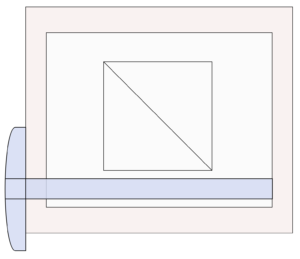A couple years back, I attended the National Unicycle Convention in Rapid City, SD. Yes, you did read “unicycle.” They do things on unicycles that you just can’t believe. Hockey, for example.


They play basketball. They race. They perform solo, pairs, and group routines. It’s totally amazing!
That brings me to this week’s activity. OK, it’s maybe not as thrilling as a unicycle hockey game, but it’s still pretty cool.
Did you know that a square is a rectangle? WHAT? Yes, a square is a rectangle.
Many people are surprised to learn this. Look up the definition of a rectangle: a four sided shape with straight sides and four right angles. Therefore, a rectangle with equal sides is a square!
We often think of the parallel sides of a rectangle as having unequal lengths, but that’s not part of the definition. So, that makes a square a rectangle, albeit a special rectangle. You could even say an equilateral rectangle….
Today we’re going to take a peek at lesson from RS2 Level G, Lesson 19. We’re going to use the drawing tools to explore squares and fractions. If you’re unfamiliar with these tools, check out the blog on Drawing Tools and Equilateral Triangles.
First, let’s draw a square. Without measuring! How cool is that? Grab your drawing board, T-square, and 45 triangle. Follow these steps:
1. Draw the baseline.

Remember to move the T-square down below the baseline before you draw the next line with the triangle. This helps you see where the line is. If you don’t believe me, try it without moving the T-square….

2. Draw the sides with the 45 triangle.


3. Draw the top line. Where to draw the line is the question.
Well, you could draw a diagonal to determine where the last line goes.

Or just use a tick mark to mark the diagonal without actually drawing the diagonal across your work.

Draw that top line….

….and TA-DA! You have a perfect square!

Now if your square isn’t quite square, I’ll bet you a unicycle wheel that somewhere along the way, your T-square wasn’t hugging the edge of the drawing board or the triangle wasn’t straight on the T-square. Try a couple more if you want. Think it through, do it again, and you’ll get it.

Got a couple good squares? Now let’s incorporate some fractions!
Start by dividing the square into halves using a diagonal line. Go ahead and mark it as 1/2 if you’d like.



Next, divide the half into half. Label it, if you’re so inclined.

Keep going.


So how far can you go?
Here’s what I did…..

This is not as complicated as you thought, right? Send me your pictures of your fraction squares!
It’s about as much fun as unicycling, right?


Photo credits: Kathleen Clayton, Arthur Kotz, and Mike Schatz

I’m proud to say that in the third picture above, the two unicyclers on the right are my son, Andy, and his wife, Irene. The three on the left are a father and his two sons.
My daughter, Connie, is in the bottom picture, the third from the left.
DEAR JOAN,
I FIRST MET YOU AT THE AMERICAN MONTESSORI CONVENTION THAT WAS HELD IN HOUSTON, TEXAS, IN 2006, 2007, OR 2008 (NOT SURE WHICH YEAR). I WAS ONE OF A VERY FEW PEOPLE, IN AN AUDIENCE OF HUNDREDS, WHO LAUGHED AT YOUR OPENING JOKE, “THE UNITED STATES IS INCHING IT’S WAY TO THE METRIC SYSTEM.”
I HAVE BEEN A JOAN COTTER DEVOTEE EVER SINCE THAT DAY !!
I LOVE THE UNICYCLE CONVENTION.
IT IS NICE TO BE ABLE TO EMAIL YOU.
PEACE AND JOY,
KAREN KETTIG
OCTOBER 17, 2016